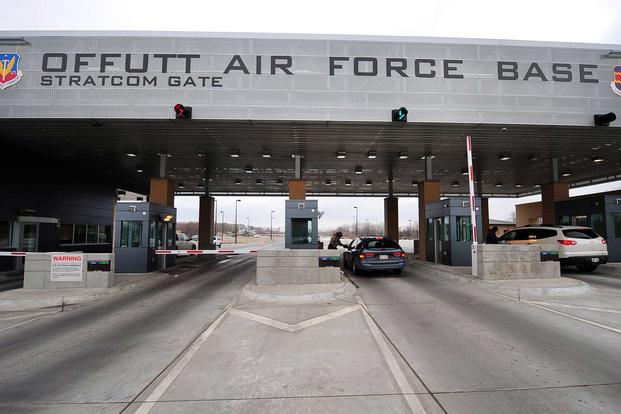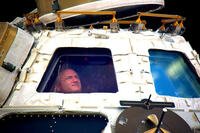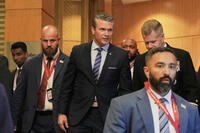Beginning Jan. 2, airmen at Offutt Air Force Base, Nebraska, will no longer be able to carry their personal firearms on base, even if they lock them up in their cars first.
Col. Gavin Marks, commander of Offutt's 55th Wing, issued the change, which the base announced in a Facebook post Monday.
"The current policy, which authorizes registered Department of Defense ID card holders with a Nebraska Concealed Handgun License (CHL) and holders of reciprocating state concealed carry license (CCL) to transport and secure privately-owned handguns in privately-owned vehicles within the base, will no longer be valid," the Facebook post reads. "This policy change comes as a result of the commander's initial review of the Offutt AFB Integrated Defense and Antiterrorism Plan, a requirement to be completed within 120 days of assuming command."
Hansen said in a statement that the policy change was "an internal decision by the commander in consultation with multiple base agencies."
Marks "has not made any recommendations to other wing commanders regarding their installation security processes," he added.
There are a few exceptions to the new policy. For example, the change has no effect on those law enforcement personnel who have a LEOSA permit, said 55th Wing spokesman Ryan Hansen.
LEOSA, the Law Enforcement Officers Safety Act, is a 2004 federal law that provides credentials for sanctioned law enforcement members to carry a concealed weapon to any state as long as they abide by state and local laws.
Related: Can You Carry a Gun on a Military Base?
The law was extended to military personnel in 2013 to give those who may have another job -- such as police officers who also serve as Guardsmen or reservists, or retired or separated service members who work as base contractors -- the ability to carry their personal weapons to their next location without violating other DoD or federal laws. The individuals must meet the law's stringent requirements, which outline who can carry weapons, and must be cleared by their respective military branch and contracting authority providing the license.
Hansen said the updated policy is still within requirements outlined in DoD Instruction 5210.56, "Arming and the Use of Force" and Air Force Instruction 31-101, "Security Forces Standards and Procedures."
"The commander's intent for this change is that firearms will be effectively controlled and safely handled on Offutt AFB and is reflective of the full confidence in the 55th Security Forces Squadron's ability to defend the installation and its personnel," the Facebook post states.
In 2016, the Air Force gave base commanders the ability to implement three programs at their discretion that all allowed additional service members to carry weapons.
Officials that year gave commanders the ability to utilize LEOSA, as well as the Unit Marshal and Security Forces Staff Arming programs.
The Unit Marshal Program (UMP) is meant to act as a Security Forces augmentee system, granting "permission to work with security forces to train airmen and allow them to open carry an M9 pistol in their duty location," the service said in a release at the time.
These airmen are supplemental, acting as additional security to SF in the event of an emergency. Members selected for UMP require additional training, the release said.
Meanwhile, Security Forces Staff Arming gives more security forces members the ability to carry a government-issued weapon while on duty, with commander approval. The members must have the appropriate Air Force Specialty Code and work in staff billets at the squadron, group, wing or major command levels, according to service officials.
The Air Force established these programs following the July 2015 shooting in Chattanooga, Tennessee, which killed four Marines and a Navy sailor. The shooter, Muhammad Youssef Abdulazeez, opened fire on two military installations -- a recruiting center, then a Navy Reserve Center.
The new policy comes in the wake of two deadly shootings aboard Navy bases this month.
On Dec. 4, a sailor, Gabriel Antonio Romero, killed two civilian contractors and himself in a shooting at the Pearl Harbor Naval Shipyard in Hawaii. He had been standing armed watch in the shipyard before he opened fire.
On Dec. 6, Saudi Royal Air Force 2nd Lt. Mohammed Saeed Alshamrani killed three and wounded eight during a shooting at Naval Air Station Pensacola, Florida.
Following the incident, FBI officials said the attack is being investigated as an act of terrorism. Alshamrani was at the base for training.
The Defense Department subsequently began a review of its screening procedures for foreign military student programs for those training alongside American troops in the U.S.
-- Oriana Pawlyk can be reached at oriana.pawlyk@military.com. Follow her on Twitter at @Oriana0214.
Read more: US Hits Iran-Backed Militia Bases in Iraq and Syria Following Deadly Rocket Attack













